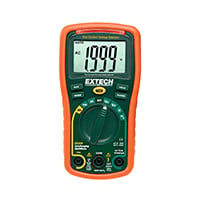EX300 Series, Multimeters
Results:
6
Manufacturer
Series
Functions, Extra
Display Digits
Response
Function
Ranging
Display Count
Ratings
Type
Display Type
Style
Features
Results remaining:6
Applied Filters:
EX300
About Multimeters
Electrical and electronic test instruments are essential tools used in various electrical and electronic trades for making a wide range of measurements. They are fundamental devices that enable technicians, engineers, and electricians to analyze and troubleshoot electrical circuits and systems.
These instruments come in different models with varying price points, feature sets, and performance levels, allowing users to choose the most suitable device for their specific needs. However, most electrical and electronic test instruments share common measurement capabilities, including the ability to measure both alternating current (AC) and direct current (DC) current and voltage, as well as test for circuit continuity.
In addition to these basic measurements, many instruments offer additional features to enhance their versatility. These features often include the measurement of temperature, resistance, capacitance, and frequency. Temperature measurement is particularly useful for assessing thermal conditions in electrical components or systems. Resistance measurement allows technicians to determine the resistance of a component or identify faulty connections. Capacitance measurement enables the assessment of capacitance values in capacitors, while frequency measurement is employed to determine the frequency of signals or waveforms.
It's important to note that these electrical and electronic test instruments are generally not designed for high-speed measurements. Instead, they are primarily used for measuring low-frequency phenomena or quantities that can be meaningfully represented as time-averaged values. For example, they are commonly used to measure the amount of current flowing in an AC-powered appliance, where the current waveform can be represented as an average value over time.
Overall, electrical and electronic test instruments are indispensable tools for professionals in the electrical and electronic industries. With their ability to measure various electrical parameters, they provide valuable insights into the behavior and performance of electrical circuits and systems, aiding in troubleshooting, maintenance, and quality control processes.




